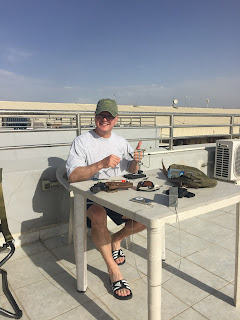Flies from Afghanistan - Part one
Flies
from Afghanistan - Part 1
Being
deployed offers many challenges; How will I perform my mission? How will I like my
fellow airmen, sailors, marines and soldiers? Will there be personal conflict? What is my level
of risk? How will my family handle my deployment?
These
questions and many others go through your head at a furious pace. Once you have
settled into a daily routine your focus can shift to your down time. How will I
pass the time
without
going nuts? Depending on your location, downtime can be tackled in numerous
ways. I have
never been much of a video game player so that is out. I love to read but that
can only last
so long. Through my many deployments the thing that keeps me going is pulling
out the bags
of feathers, yarn, and hooks and creating something that can transport you to a
spot halfway
around the globe. A spot in your mind where you can smell the moss and cedar,
hear the
rush of the current and share the company of the kingfisher and chickadee. As
Norman Maclean
said so aptly, “I am haunted by waters”…..and so I am, they are a perfect
escape from
a not so perfect situation.
Over
a sixth month deployment one can find quite a bit of downtime. I was recently deployed
as an Air Advisor to the Afghan Air Force and was embedded with the Afghan
C-130 squadron
out of Kabul, Afghanistan. The Afghan’s are truly remarkable people. So many of them
want a better life for themselves and their country and to meet and get to know
them makes
their struggles become more acute. You truly want them to succeed and find
peace in their
private chaos.
Having
an escape is critical to being able to perform day in and day out at a high
level in
a stressful situation, as I mentioned above fly-tying is my personal escape. One
of my “goals” during
my deployment was to fill my boxes with many of my go to patterns and also
teach myself
some new skills. I am happy to say that my goals were generally met. I tied
hundreds of flies,
many to catch steel, and was able to learn new techniques along the way, most
notably tying
tube flies. I also finally learned how to effectively tie small parachute
patterns. The
first installment of “Flies from Afghanistan” focuses on what I consider my “go
to” steelhead
pattern; the Sucker Spawn. This pattern is essentially a modified version of
the Glo Bug
and once you learn the tying technique it is pretty easy to tie up a pile to
fill your box.
Here
is the material list:
Hooks: #8 Tiemco 2457, I buy these in packs of 100
Thread: Orange or red Kevlar thread
Yarn material: Mcfly Foam Yarn, in whatever color suits your fancy. My most successful colors are; Ripple, Cerise, Early Girl, Orange, and Baby Blue.
Flash: Pearl Krystal Flash
How to tie:
To
tie the pattern I lay down a base of thread along the entire shank of the hook. I tie in a
small bunch of Krystal Flash creating a small “tail”. I tie in a small length
of McFly Foam at about
the location on the hook directly above the barb, the foam will be trailing
from the rear of the
hook.
To
prepare the McFly Foam for tying I pull the material from the package and open
it up. It roughly separates into strands. I peel off a strand that is roughly the
diameter of a dime. I take
this strand and cut it in half. I usually prepare several strands before I
start tying. The shorter
the strands are the easier it is to manipulate the material during the tying
process.
I’m
a right handed tyer so I tie in the strand with it trailing off the rear of the
hook to the left. I then take my dubbing needle in my left hand fold the foam over the needle
making a small,
tight loop then I make several tight wraps of thread to tie it off, do
not cut the foam. I then
make another loop of foam with the needle, this time slightly larger than the
last, tying it off
as close as you can against the first. The third loop is usually the largest
loop again tying it off
as close as possible to the one before it. This loop should be at about the
middle of the hook. I then begin to make the next loops smaller than the one before it.
The
general idea is to have the fly be oval in shape when you look at it from
above. The last loop should be a tight one. Tie off. I also usually coat the head and underside with some sort of head
cement.
There
you have it, the Sucker Spawn. Once you get the hang of the technique you can really
crank these out and it can be fished just like any egg pattern using split shot
or a slinky.
I’ll be back soon with another installment right in time for steelhead season. Birdog - Minnesota Steelheader | Director






Comments